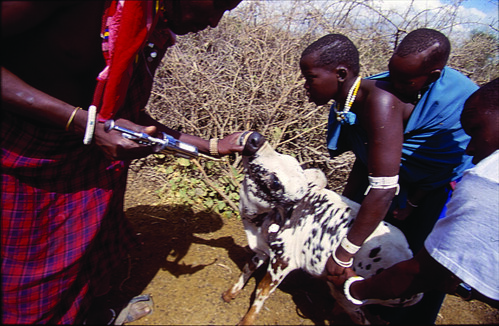 As the board of trustees of the International Livestock Research Institute (ILRI) meets in Addis Ababa, Ethiopia, this week, reviewing ILRI’s animal health research among other work, an ILRI vaccine project is highlighted in a new publication, DFID Research 2009–2010: Providing research evidence that enables poverty reduction. The UK Department for International Development (DFID) and the Bill & Melinda Gates Foundation both support the Global Alliance in Livestock Veterinary Medicines (GALVmed), which works to convert existing or near-market technologies into livestock medicines and vaccines for use in developing countries. The notable success of this strategy in 2009, says DFID, is an East Coast fever vaccine produced by ILRI. East Coast fever is a tick-transmitted disease that kills one cow every 30 seconds in eastern, central and southern Africa, where it threatens some 25 million cattle in 11 countries and is now putting at risk a further 10 million animals in new regions, such as southern Sudan, where the disease has been spreading at a rate of more than 30 kilometres a year. The disease is a major cattle killer. In herds kept by the pastoralist Maasai, it kills 20–50% of all unvaccinated calves, which makes it difficult and often impossible for the herders to plan for the future or to improve their livestock enterprises. A vaccine for East Coast fever could save over a million cattle and up to £170 million a year in the 11 countries where the disease is now endemic. An experimental vaccine against East Coast fever, which makes use of live but weakened parasites, has existed for more than three decades, with batches mass produced in ILRI’s Nairobi laboratories. Although constrained by the need for a ‘cold chain’ to keep the ‘live’ vaccine viable, field use of this vaccine in Tanzania and elsewhere has proved it to be highly effective and in demand by poor livestock keepers, who are paying for the vaccine to keep their animals alive. GALVmed has worked with ILRI and private companies, such as VetAgro Tanzania Ltd., to make East Coast fever vaccine available to the livestock keepers who need it most and to scale up production in future. With £16.5 million provided by DFID and the BMGF, GALVmed began working on the registration and commercial distribution and delivery of a new batch of the vaccine produced by ILRI. The vaccine was successfully registered in 2009 in Malawi and Kenya, with Tanzania and Uganda expected to follow soon. If it is approved in Uganda, it will be the first veterinary vaccine formally registered in that country. GALVmed is now working to establish viable commercial production and delivery systems, aiming that by the end of 2011, all aspects of the production and delivery of East Coast fever vaccine are in private hands.
As the board of trustees of the International Livestock Research Institute (ILRI) meets in Addis Ababa, Ethiopia, this week, reviewing ILRI’s animal health research among other work, an ILRI vaccine project is highlighted in a new publication, DFID Research 2009–2010: Providing research evidence that enables poverty reduction. The UK Department for International Development (DFID) and the Bill & Melinda Gates Foundation both support the Global Alliance in Livestock Veterinary Medicines (GALVmed), which works to convert existing or near-market technologies into livestock medicines and vaccines for use in developing countries. The notable success of this strategy in 2009, says DFID, is an East Coast fever vaccine produced by ILRI. East Coast fever is a tick-transmitted disease that kills one cow every 30 seconds in eastern, central and southern Africa, where it threatens some 25 million cattle in 11 countries and is now putting at risk a further 10 million animals in new regions, such as southern Sudan, where the disease has been spreading at a rate of more than 30 kilometres a year. The disease is a major cattle killer. In herds kept by the pastoralist Maasai, it kills 20–50% of all unvaccinated calves, which makes it difficult and often impossible for the herders to plan for the future or to improve their livestock enterprises. A vaccine for East Coast fever could save over a million cattle and up to £170 million a year in the 11 countries where the disease is now endemic. An experimental vaccine against East Coast fever, which makes use of live but weakened parasites, has existed for more than three decades, with batches mass produced in ILRI’s Nairobi laboratories. Although constrained by the need for a ‘cold chain’ to keep the ‘live’ vaccine viable, field use of this vaccine in Tanzania and elsewhere has proved it to be highly effective and in demand by poor livestock keepers, who are paying for the vaccine to keep their animals alive. GALVmed has worked with ILRI and private companies, such as VetAgro Tanzania Ltd., to make East Coast fever vaccine available to the livestock keepers who need it most and to scale up production in future. With £16.5 million provided by DFID and the BMGF, GALVmed began working on the registration and commercial distribution and delivery of a new batch of the vaccine produced by ILRI. The vaccine was successfully registered in 2009 in Malawi and Kenya, with Tanzania and Uganda expected to follow soon. If it is approved in Uganda, it will be the first veterinary vaccine formally registered in that country. GALVmed is now working to establish viable commercial production and delivery systems, aiming that by the end of 2011, all aspects of the production and delivery of East Coast fever vaccine are in private hands.
East Coast fever vaccine comes to market in eastern and southern Africa
3

